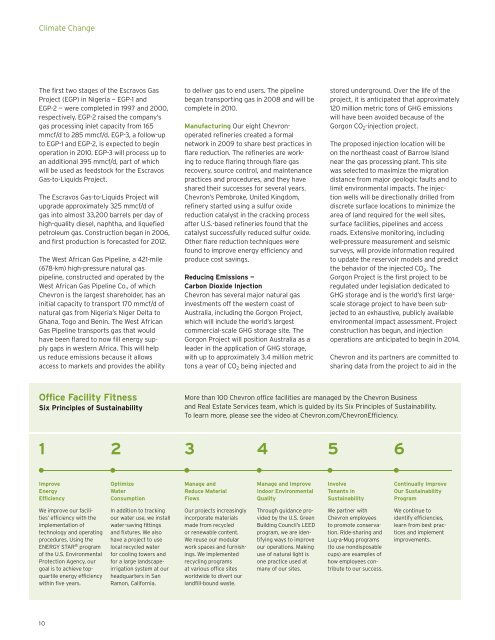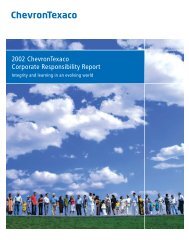Chevron Corporate Responsibility Report 2009
Chevron Corporate Responsibility Report 2009
Chevron Corporate Responsibility Report 2009
Create successful ePaper yourself
Turn your PDF publications into a flip-book with our unique Google optimized e-Paper software.
Climate Change<br />
The first two stages of the Escravos Gas<br />
Project (EGP) in Nigeria — EGP-1 and<br />
EGP-2 — were completed in 1997 and 2000,<br />
respectively. EGP-2 raised the company’s<br />
gas processing inlet capacity from 165<br />
mmcf/d to 285 mmcf/d. EGP-3, a follow-up<br />
to EGP-1 and EGP-2, is expected to begin<br />
operation in 2010. EGP-3 will process up to<br />
an additional 395 mmcf/d, part of which<br />
will be used as feedstock for the Escravos<br />
Gas-to-Liquids Project.<br />
The Escravos Gas-to-Liquids Project will<br />
upgrade approximately 325 mmcf/d of<br />
gas into almost 33,200 barrels per day of<br />
high-quality diesel, naphtha, and liquefied<br />
petroleum gas. Construction began in 2006,<br />
and first production is forecasted for 2012.<br />
The West African Gas Pipeline, a 421-mile<br />
(678-km) high-pressure natural gas<br />
pipeline, constructed and operated by the<br />
West African Gas Pipeline Co., of which<br />
<strong>Chevron</strong> is the largest shareholder, has an<br />
initial capacity to transport 170 mmcf/d of<br />
natural gas from Nigeria’s Niger Delta to<br />
Ghana, Togo and Benin. The West African<br />
Gas Pipeline transports gas that would<br />
have been flared to now fill energy supply<br />
gaps in western Africa. This will help<br />
us reduce emissions because it allows<br />
access to markets and provides the ability<br />
to deliver gas to end users. The pipeline<br />
began transporting gas in 2008 and will be<br />
complete in 2010.<br />
Manufacturing Our eight <strong>Chevron</strong>operated<br />
refineries created a formal<br />
network in <strong>2009</strong> to share best practices in<br />
flare reduction. The refineries are working<br />
to reduce flaring through flare gas<br />
recovery, source control, and maintenance<br />
practices and procedures, and they have<br />
shared their successes for several years.<br />
<strong>Chevron</strong>’s Pembroke, United Kingdom,<br />
refinery started using a sulfur oxide<br />
reduction catalyst in the cracking process<br />
after U.S.-based refineries found that the<br />
catalyst successfully reduced sulfur oxide.<br />
Other flare reduction techniques were<br />
found to improve energy efficiency and<br />
produce cost savings.<br />
Reducing Emissions —<br />
Carbon Dioxide Injection<br />
<strong>Chevron</strong> has several major natural gas<br />
investments off the western coast of<br />
Australia, including the Gorgon Project,<br />
which will include the world’s largest<br />
commercial-scale GHG storage site. The<br />
Gorgon Project will position Australia as a<br />
leader in the application of GHG storage,<br />
with up to approximately 3.4 million metric<br />
tons a year of CO 2 being injected and<br />
stored underground. Over the life of the<br />
project, it is anticipated that approximately<br />
120 million metric tons of GHG emissions<br />
will have been avoided because of the<br />
Gorgon CO 2 -injection project.<br />
The proposed injection location will be<br />
on the northeast coast of Barrow Island<br />
near the gas processing plant. This site<br />
was selected to maximize the migration<br />
distance from major geologic faults and to<br />
limit environmental impacts. The injection<br />
wells will be directionally drilled from<br />
discrete surface locations to minimize the<br />
area of land required for the well sites,<br />
surface facilities, pipelines and access<br />
roads. Extensive monitoring, including<br />
well- pressure measurement and seismic<br />
surveys, will provide information required<br />
to update the reservoir models and predict<br />
the behavior of the injected CO 2 . The<br />
Gorgon Project is the first project to be<br />
regulated under legislation dedicated to<br />
GHG storage and is the world’s first largescale<br />
storage project to have been subjected<br />
to an exhaustive, publicly available<br />
environmental impact assessment. Project<br />
construction has begun, and injection<br />
operations are anticipated to begin in 2014.<br />
<strong>Chevron</strong> and its partners are committed to<br />
sharing data from the project to aid in the<br />
Office Facility Fitness<br />
Six Principles of Sustainability<br />
More than 100 <strong>Chevron</strong> office facilities are managed by the <strong>Chevron</strong> Business<br />
and Real Estate Services team, which is guided by its Six Principles of Sustainability.<br />
To learn more, please see the video at <strong>Chevron</strong>.com/<strong>Chevron</strong>Efficiency.<br />
1<br />
2<br />
3<br />
4<br />
5<br />
6<br />
Improve<br />
Energy<br />
Efficiency<br />
Optimize<br />
Water<br />
Consumption<br />
Manage and<br />
Reduce Material<br />
Flows<br />
Manage and Improve<br />
Indoor Environmental<br />
Quality<br />
Involve<br />
Tenants in<br />
Sustainability<br />
Continually Improve<br />
Our Sustainability<br />
Program<br />
We improve our facilities’<br />
efficiency with the<br />
implementation of<br />
technology and operating<br />
procedures. Using the<br />
ENERGY STAR ® program<br />
of the U.S. Environmental<br />
Protection Agency, our<br />
goal is to achieve topquartile<br />
energy efficiency<br />
within five years.<br />
In addition to tracking<br />
our water use, we install<br />
water-saving fittings<br />
and fixtures. We also<br />
have a project to use<br />
local recycled water<br />
for cooling towers and<br />
for a large landscapeirrigation<br />
system at our<br />
headquarters in San<br />
Ramon, California.<br />
Our projects increasingly<br />
incorporate materials<br />
made from recycled<br />
or renewable content.<br />
We reuse our modular<br />
work spaces and furnishings.<br />
We implemented<br />
recycling programs<br />
at various office sites<br />
worldwide to divert our<br />
landfill-bound waste.<br />
Through guidance provided<br />
by the U.S. Green<br />
Building Council’s LEED<br />
program, we are identifying<br />
ways to improve<br />
our operations. Making<br />
use of natural light is<br />
one practice used at<br />
many of our sites.<br />
We partner with<br />
<strong>Chevron</strong> employees<br />
to promote conservation.<br />
Ride-sharing and<br />
Lug-a-Mug programs<br />
(to use nondisposable<br />
cups) are examples of<br />
how employees contribute<br />
to our success.<br />
We continue to<br />
identify efficiencies,<br />
learn from best practices<br />
and implement<br />
improvements.<br />
10

















